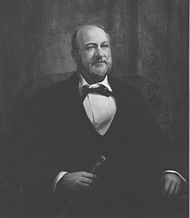Peter Turney | |
|---|---|
 Portrait of Turney by Lloyd Branson | |
| 26th Governor of Tennessee | |
| In office January 16, 1893 – January 21, 1897 | |
| Preceded by | John P. Buchanan |
| Succeeded by | Robert Love Taylor |
| Chief Justice of the Tennessee Supreme Court | |
| In office 1886–1893 | |
| Preceded by | James W. Deaderick |
| Succeeded by | Horace H. Lurton[1] |
| Personal details | |
| Born | September 22, 1827 Jasper, Tennessee |
| Died | October 19, 1903 (aged 76) Winchester, Tennessee |
| Resting place | Winchester City Cemetery |
| Political party | Democratic |
| Spouse(s) | Cassandra Garner (1851–1857, her death) Hannah Graham (m. 1858) |
| Relations | Hopkins L. Turney (father) |
| Profession | Attorney |
| Military service | |
| Allegiance | |
| Branch/service | |
| Years of service | 1861–1865 |
| Rank | |
| Commands | |
| Battles/wars | American Civil War • Bull Run (1861) • Shenandoah Campaign (1862) • Seven Days (1862) • Peninsula Campaign (1862) • Fredericksburg (1862) |
Peter Turney (September 22, 1827 – October 19, 1903) was an American politician, soldier, and jurist, who served as the 26th governor of Tennessee from 1893 to 1897. He was also a justice of the Tennessee Supreme Court from 1870 to 1893, and served as the court's Chief Justice from 1886 to 1893. During the Civil War, Turney was colonel of the First Tennessee Regiment, one of the first Tennessee units to join the Confederate Army.[2][3]
As governor, Turney ended the state's controversial convict lease system and enacted other prison reform measures. His second term was marred by the 1894 gubernatorial election, which he won only after the state's Democratic-controlled legislature threw out thousands of votes for his opponent, Henry Clay Evans.[2]
- ^ Cite error: The named reference
greenbagwas invoked but never defined (see the help page). - ^ a b Leonard Schlup, "Peter Turney," Tennessee Encyclopedia of History and Culture, 2009. Retrieved: 15 November 2012.
- ^ Tim Stowell, "Tennessee Confederate Regimental Sketches," TNGenWeb.org. Retrieved: 15 November 2012.